Ditapis dengan
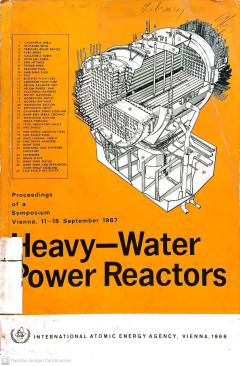
Heavy-Water Power Reactors: Proceedings of a Symposium Vienna, 11-15 Septembe…
Heavy-water reactors have evoked a great deal of interest since the early days of atomic power development. These reactors, by virtue of their good neutron economy, offer certain advantages over other types, including lower fuel inventory, versatility in fuel cycle with the possibility of using natural or enriched uranium as well as thorium, better fuel utilization, and consequently low fuel cy…
- Edisi
- -
- ISBN/ISSN
- -
- Deskripsi Fisik
- 981 p: illus.; 24 cm.
- Judul Seri
- Proceedings Series
- No. Panggil
- 621.483 IAE h
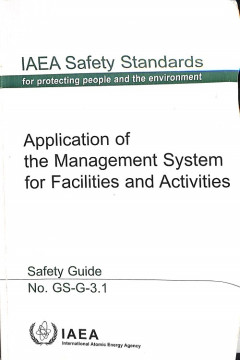
Application of the Management System for Facilities and Activities, Safety Guide
This publication provides guidance for following the requirements for management systems that integrate safety, health, security, quality assurance and environmental objectives. A successful management system ensures that nuclear safety matters are not dealt with in isolation but are considered within the context of all these objectives. The aim of this publication is to assist Member States to…
- Edisi
- -
- ISBN/ISSN
- -
- Deskripsi Fisik
- 105 p. : Illus. ; 24 cm
- Judul Seri
- Safety Standards Series No. GS-G-3.1
- No. Panggil
- 633.10486IAE A
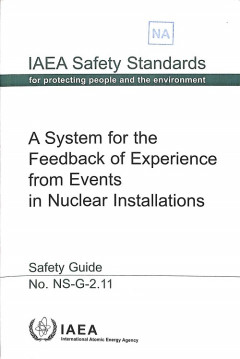
A System for the Feedback of Experience from Events in Nuclear Installations
This Safety Guide provides recommendations on all the main components of operating experience feedback systems, utilizing relevant information on events and abnormal conditions that have occurred at nuclear installations around the world. It focuses on the interaction between the different systems for using operating experience feedback and constitutes an update and an extension of Part I: A Na…
- Edisi
- -
- ISBN/ISSN
- 9201014066 / 1020525X
- Deskripsi Fisik
- 61 p. : Illus. ; 24 cm
- Judul Seri
- Safety Standards Series No. NS-G-2.11
- No. Panggil
- 621.483 IAE A

Release of Sites from Regulatory Control on Termination of Practices, Safety …
An increasing number of nuclear facilities are coming to the end of their useful lives and are being, or are going to be, decommissioned with a view to removing the sites from regulatory control. In many cases, decommissioning activities include the decontamination of land, buildings and other structures such as underground pipes and tanks, or ponds, at the site that became contaminated as a re…
- Edisi
- -
- ISBN/ISSN
- 9201016069 / 1020525X
- Deskripsi Fisik
- 37 p. : Illus. ; 24 cm
- Judul Seri
- Safety Standards No. WS-G-5.1
- No. Panggil
- -
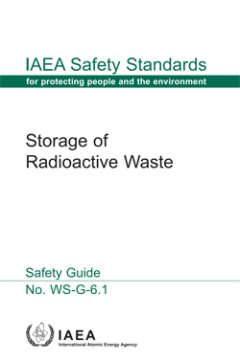
Storage of Radioactive Waste, Safety Guide
Radioactive waste is generated in a broad range of activities involving a wide variety of radioactive materials associated with, for example, the operation of nuclear facilities, the use of sealed radioactive sources in industry, the use of human made radionuclides in hospitals and laboratories, and the decommissioning of such facilities. The physical, chemical and radiological characteristics …
- Edisi
- -
- ISBN/ISSN
- 9201067062 / 1020525X
- Deskripsi Fisik
- 55 p. : Illus. ; 24 cm
- Judul Seri
- Safety Standards Series No. WS-G-6.1
- No. Panggil
- -
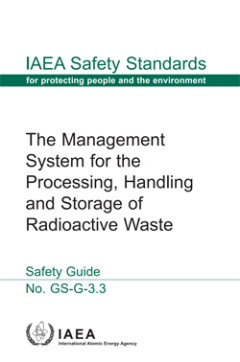
THE MANAGEMENT SYSTEM FOR THE PROCESSING, HANDLING AND STORAGE OF RADIOACTIVE…
The objective of this Safety Guide is to provide guidance on the development and implementation of management systems for the pretreatment, treatment, conditioning and storage of radioactive waste. This publication also includes a description of how to apply the requirements detailed in IAEA Safety Standards Series No. GS-R-3, to the activities associated with producing a packaged waste form fo…
- Edisi
- -
- ISBN/ISSN
- 9789201020086 / 1020525X
- Deskripsi Fisik
- 79 p. : Illus. ; 24 cm
- Judul Seri
- Safety Standards Series No. GS-G-3.3
- No. Panggil
- -
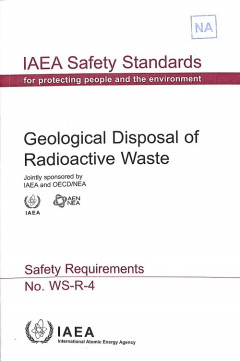
Geological Disposal of Radioactive Waste, Safety Requirements
The objective of this Safety Requirements publication is to set down the protection objectives and criteria for geological disposal and to establish the requirements that must be met to ensure the safety of this disposal option, consistent with the established principles of safety for radioactive waste management.
- Edisi
- -
- ISBN/ISSN
- 920105705
- Deskripsi Fisik
- 49 p. : Illus. ; 24 cm
- Judul Seri
- Safety Standards Series No. WS-R-4
- No. Panggil
- -
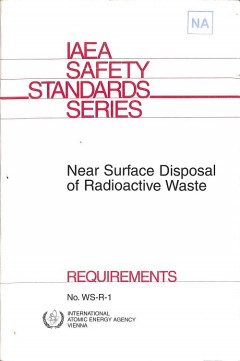
Near Surface Disposal of Radioactive Waste, Requirements
This publication sets out the basic safety requirements related to the disposal of radioactive wastes in near surface repositories. As a Safety Requirements publication it is supported by a number of associated Safety Guides which provide guidance on the implementation of the requirements. Its principles are derived from the Safety Fundamentals publication, Safety Series No. 111-F, The Principl…
- Edisi
- -
- ISBN/ISSN
- 9201010990 / 1020525X
- Deskripsi Fisik
- 29 p. : Illus. 24 cm
- Judul Seri
- Safety Standards Series No. WS-R-1
- No. Panggil
- 621.0397 IAE n
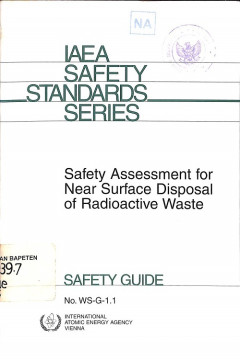
Safety Assessment for Near Surface Disposal of Radioactive Waste
This Safety Guide provides recommendations on how to meet the requirements related to safety assessment in the Safety Requirements publication, Safety Standards Series No. WS-R-1, Near Surface Disposal of Radioactive Waste. It addresses the subject of safety assessment for near surface disposal of radioactive waste and provides guidance on approaches to performing safety assessments in the cont…
- Edisi
- -
- ISBN/ISSN
- 9201012993 / 1020525X
- Deskripsi Fisik
- 31 p. : Illus. ; 24 cm
- Judul Seri
- Safety Standards Series No. WS-G-1.1
- No. Panggil
- 621.0397 IAE s
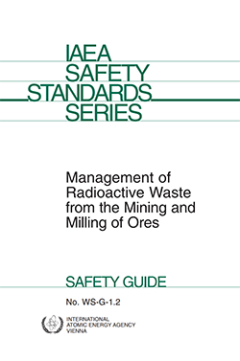
Management of Radioactive Waste from the Mining and Milling of Ores, Safety G…
This Safety Guide provides recommendations and guidance on the safe management of radioactive waste resulting from the mining and milling of ores, with the purpose of protecting workers, the public and the environment from the consequences of these activities. It supplements Safety Standards Series No. WS-R-1, Near Surface Disposal of Radioactive Waste.
- Edisi
- -
- ISBN/ISSN
- 9201158025 / 1020525X
- Deskripsi Fisik
- 39 p. : Illus. ; 24 cm
- Judul Seri
- Safety Standards Series No. WS-G-1.2
- No. Panggil
- -
 Karya Umum
Karya Umum  Filsafat
Filsafat  Agama
Agama  Ilmu-ilmu Sosial
Ilmu-ilmu Sosial  Bahasa
Bahasa  Ilmu-ilmu Murni
Ilmu-ilmu Murni  Ilmu-ilmu Terapan
Ilmu-ilmu Terapan  Kesenian, Hiburan, dan Olahraga
Kesenian, Hiburan, dan Olahraga  Kesusastraan
Kesusastraan  Geografi dan Sejarah
Geografi dan Sejarah